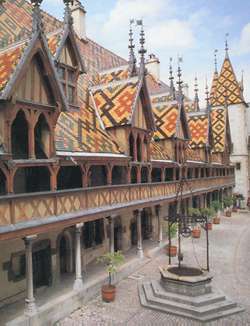The
Hôtel-Dieu (Hospices de Beaune) was the foundation of two of the
most remarkable figures in Burgundian history, Nicolas
Rolin and his wife, Guigone de Salins.
Nicolas was the outstanding figure of his age and served Philippe
le Bon much as Colbert was to serve Louis XIV. Philippe had been quick
to recognize his ability. Therefore the good duke, wishing to recompense
him for such labours, made him rich. Guigone, descended from the two noble
houses of Vienne and Salins, was a wife to match so capable a spouse.

Rolin was called to administer Burgundy at a time of great difficulty and poverty. In 1435, by the Treaty of Arras, the duke of Burgundy and the king of France had united to expel the English, but in doing so they had unwittingly created an even deadlier foe. The disbanded soldiers formed themselves into companies of brigands - les écorcheurs- who terrorized the countryside to such an extent that the peasants were obliged to abandon their fields and take refuge in the fortified towns and châteaux. The abandonment of the crops bred famine and famine bred pestilence. The poor were dying by the thousand. Beaune was at this time one of the hardest-hit areas in Burgundy. Of 465 hearths, only 27 were solvent.
It was
probably for this reason that Rolin chose Beaune for the foundation of
his hospice. He immediately set about the realization of this undertaking,
and the building which resulted is one of the most famous in Burgundy.
It is the roof which is the particular
glory of the whole building, one of the typically Burgundian use of coloured
tiles.
This delightful palace of the poor recalls, in its elegant originality,
the municipal buildings of Flanders ; it is the art of Flanders at its
most brilliant period, transported to Burgundy.

